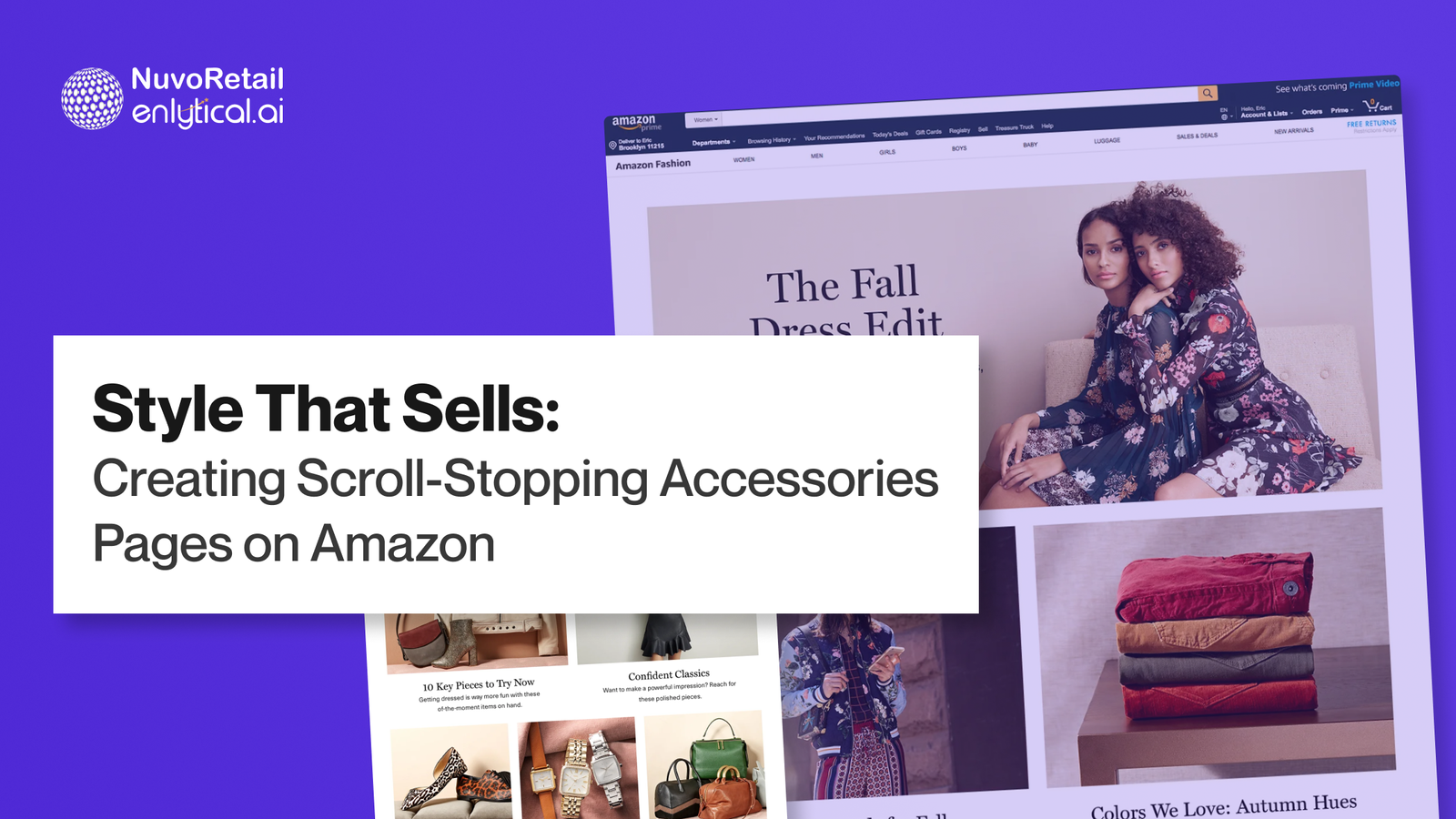Style That Sells: Creating Scroll-Stopping Accessories Pages on Amazon

In the world of online retail, accessories are more than just finishing touches – they’re style statements, impulse drivers, and high-margin add-ons that can elevate your average order value (AOV). But because they’re often seen as secondary to apparel or footwear, their digital presence tends to be overlooked.
In browse-based shopping, customers are often exploring without a specific item in mind. That’s where your accessories category can shine – by guiding them toward visually compelling, easy-to-buy pieces that complete a look or spark a spontaneous purchase. Whether you’re selling on your own platform or a global marketplace like Amazon, mastering how your product listings appear in the browse grid is critical.
Here’s how to craft a high-performing browse experience for accessories that inspires discovery and drives conversion:
Use Detail-Rich, Zoomed-In Visuals to Elevate Amazon Product Listings
Accessories thrive on detail – the shine of a metal clasp, the texture of a woven belt, the grain of a leather handbag.
Close-up shots are a must for texture-heavy items like bags, jewelry, or scarves.
Lifestyle imagery helps buyers understand scale and how the accessory pairs with an outfit.
Consistent lighting and clean backgrounds maintain a premium look across the grid.
Pro Tip: Include size reference shots – like a clutch held in hand or earrings worn – to avoid surprises post-purchase. This is especially crucial on Amazon, where customers rely on visuals as a primary trust signal within product listings.
Organize Amazon Listings by Type, Style & Occasion for Seamless Browsing
Shoppers rarely browse all accessories at once. They’re usually after something specific – like a statement necklace for a wedding or a minimalist tote for work.
Use smart filters and collections:
Type: Belts, Bags, Jewelry, Sunglasses, Scarves, etc.
Style: Minimalist, Statement, Vintage, Boho, Classic, etc.
Material: Leather, Metal, Cotton, Faux Fur, etc.
Occasion: Daily Wear, Party Edit, Gifting, Vacation Picks
Pro Tip: Add use-case tags like “WFH Accessories,” “Date Night Essentials,” or “Festival Picks” for added relevance – even in your A+ Content modules to reinforce category utility and style inspiration.
Showcase Variants & Colors Clearly Within Product Listings and A+ Content
Color plays a huge role in accessory choices – especially for bags, scarves, and jewelry.
Use visual color swatches (not just text) on product tiles.
Show alternate views (e.g., different colors or finishes) when a user hovers over the image.
Keep product titles concise but include variant-specific terms like “Gold-Plated” or “Tan Leather”.
Pro Tip: Group similar items under one parent SKU with clickable thumbnails instead of duplicating listings – this not only improves UX but aligns with Amazon’s product listing optimization standards.
Highlight Gifting Potential Using Amazon A+ Content Modules
Accessories are often go-to gifts – affordable, stylish, and low-risk. Make this easier for shoppers by:
- Adding “Gift Ideas” or “Under ₹1000” curated categories.
- Highlighting “Gift-Wrap Available” tags or icons.
- Including reviews that mention gifting success right on the product grid or quick view.
Pro Tip: During peak gifting seasons like festivals or holidays, use A+ Content to create dedicated gift guides or comparison charts – a common strategy among top-selling Amazon brands.
Drive Impulse Buys with Smart Merchandising in Amazon Product Listings
Accessories are frequently added last-minute to the cart – that’s your opportunity.
Create “Complete the Look” suggestions across apparel pages.
Place accessories on homepage carousels or under “Trending Now” sections.
Enable bundles or combo offers like “Buy 2, Get 1 Free” or “Matching Set Available”.
Pro Tip: Use urgency tactics like “Only 2 Left” or “Bestseller” on product listings. If you’re on Amazon, these can be built into A+ Content modules or leveraged via backend tagging.
Let Filters on Amazon Work for You, Not Against You
Cluttered or irrelevant filters frustrate shoppers. Keep them sharp and category-specific.
Ideal filters:
- Type (e.g., “Stud Earrings” vs. “Drop Earrings”)
- Finish (Gold, Silver, Matte, Glossy)
- Occasion
- Price Range
- Material (e.g., Metal, Faux Leather, Beaded)
- Customer Rating
Pro Tip: Make filters collapsible and sticky on mobile to preserve usability without taking up screen space. Filterability is especially critical for Amazon’s browse-based discovery, where relevance and ease can directly impact impressions and CTRs.
Incorporate User-Generated Content to Strengthen Social Proof on Product Pages
Accessories often have strong visual impact when worn by real people. UGC and reviews can do wonders here.
Show real-life styling images from customers in product hover states or carousels.
Feature “Top Rated By Customers” or “As Seen On Instagram” badges.
Encourage reviews that mention versatility, styling tips, and compliments received.
Pro Tip: On platforms like Amazon, leverage A+ Content to include lifestyle shots or testimonial quotes. It humanizes your brand and builds confidence through relatable social proof.
Optimize Accessories Product Listings for Mobile-First Amazon Shoppers
With a large chunk of shoppers browsing on their phones, ensure your mobile UX is tight.
Grid should display 2–3 items per row with large tap zones.
Swatches and filters should be thumb-friendly and collapsible.
Enable quick-add or wishlist directly from the product tile.
Pro Tip: Don’t hide filters behind menus – make them visible upfront to encourage refining results. Also, test how your A+ Content renders on mobile, especially if you’re selling on Amazon, where a significant percentage of beauty and fashion purchases happen via mobile.
Conclusion:
In online retail, accessories may be small in size – but they’re mighty when it comes to revenue and customer experience. By fine-tuning your browse pages with beautiful imagery, intelligent filters, trend-driven merchandising, and mobile optimization, you can turn casual scrollers into confident buyers. And whether you’re selling through your DTC website or on Amazon, remember: a high-performing accessories strategy isn’t just about the product – it’s about how your product listings and A+ Content guide and inspire shoppers throughout their journey.
The key is to treat accessories as standalone heroes, not just sidekicks. Because in the right hands – and the right layout – even the smallest detail can deliver your next biggest sale.




